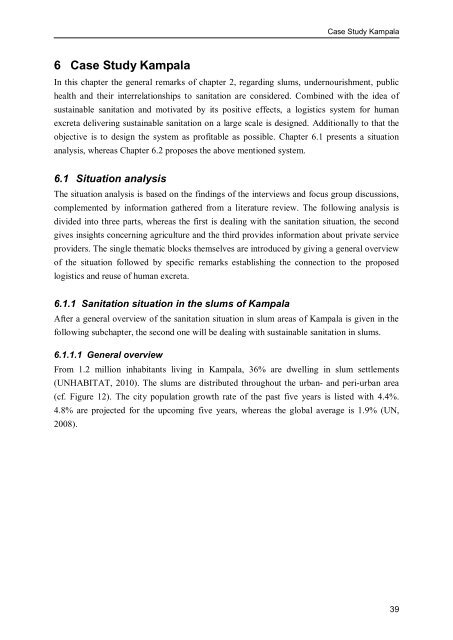Economic Effects of Sustainable Sanitation - SuSanA
Economic Effects of Sustainable Sanitation - SuSanA
Economic Effects of Sustainable Sanitation - SuSanA
You also want an ePaper? Increase the reach of your titles
YUMPU automatically turns print PDFs into web optimized ePapers that Google loves.
6 Case Study Kampala<br />
Case Study Kampala<br />
In this chapter the general remarks <strong>of</strong> chapter 2, regarding slums, undernourishment, public<br />
health and their interrelationships to sanitation are considered. Combined with the idea <strong>of</strong><br />
sustainable sanitation and motivated by its positive effects, a logistics system for human<br />
excreta delivering sustainable sanitation on a large scale is designed. Additionally to that the<br />
objective is to design the system as pr<strong>of</strong>itable as possible. Chapter 6.1 presents a situation<br />
analysis, whereas Chapter 6.2 proposes the above mentioned system.<br />
6.1 Situation analysis<br />
The situation analysis is based on the findings <strong>of</strong> the interviews and focus group discussions,<br />
complemented by information gathered from a literature review. The following analysis is<br />
divided into three parts, whereas the first is dealing with the sanitation situation, the second<br />
gives insights concerning agriculture and the third provides information about private service<br />
providers. The single thematic blocks themselves are introduced by giving a general overview<br />
<strong>of</strong> the situation followed by specific remarks establishing the connection to the proposed<br />
logistics and reuse <strong>of</strong> human excreta.<br />
6.1.1 <strong>Sanitation</strong> situation in the slums <strong>of</strong> Kampala<br />
After a general overview <strong>of</strong> the sanitation situation in slum areas <strong>of</strong> Kampala is given in the<br />
following subchapter, the second one will be dealing with sustainable sanitation in slums.<br />
6.1.1.1 General overview<br />
From 1.2 million inhabitants living in Kampala, 36% are dwelling in slum settlements<br />
(UNHABITAT, 2010). The slums are distributed throughout the urban- and peri-urban area<br />
(cf. Figure 12). The city population growth rate <strong>of</strong> the past five years is listed with 4.4%.<br />
4.8% are projected for the upcoming five years, whereas the global average is 1.9% (UN,<br />
2008).<br />
39

















